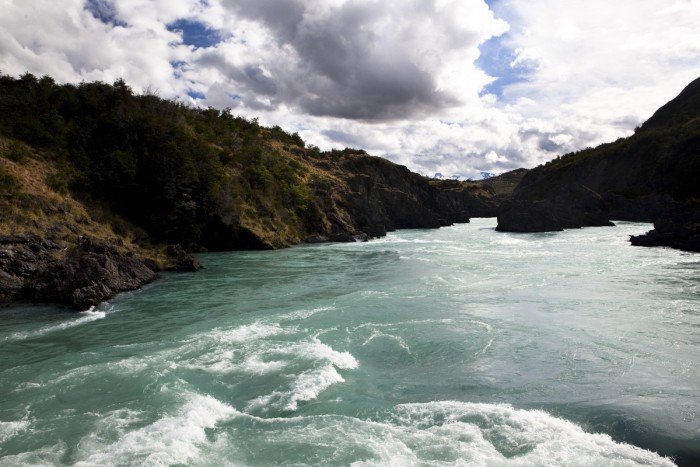 The Baker River near Estancia Chacabuco, future Patagonia National Park.. ©Daniel Beltra
The Baker River near Estancia Chacabuco, future Patagonia National Park.. ©Daniel BeltraBy Amanda Maxwell
Chile’s government – under the leadership of President Bachelet – made a landmark decision today when it rejected the controversial HidroAysén dam project. "The HydroAysen hydroelectric project is rejected," declared the Minister of the Environment upon announcing the decision this morning. This is a major victory for the majority of Chileans and the tens of thousands of people around the world who oppose building large, unsustainable dams in wild Patagonia – and for those who think that Chile can be a global clean energy leader by developing its remarkable potential for renewables* and energy efficiency.
Background: 2008-2014
HidroAysén first proposed to build its five large dams on the breathtaking Baker and Pascua Rivers in Patagonia in 2008. At that time, most people assumed the dams were a foregone conclusion. “It’s dams or coal,” people would say with a shrug, repeating the assumption that those were the only two reliable energy sources for Chile. Despite that, a remarkable group of people got together to form the Patagonia Defense Council, (or CDP, of which I am proud to say NRDC is a member) to fight HidroAysén. The CDP’s work has led the way for an ever-increasing number of people to join the cause –officially or not—and call for a “Patagonia sin Represas / Patagonia without Dams.”
Over the years, the HidroAysén controversy got more and more attention in Chile and internationally, especially after the dams received their environmental approval in 2011. As other energy options, such as renewable energy and energy efficiency, became recognized and cost-competitive, even more people joined the cause. Even HidroAysén’s two owners (the Chilean energy company Colbún and Endesa Chile, the Chilean subsidiary of the Italian energy giant Enel) displayed decreasing confidence in their project.
Something remarkable happened: the conversation changed from “It’s dams or coal,” to “What kind of energy future does Chile want?” and the HidroAysén debate grew into the largest environmental battle in Chile’s history.
Today’s Decision: What Does It Mean?
The long-awaited and highly-anticipated decision today came from Chile’s Committee of Ministers, which is comprised of rotating cabinet-level ministers working under the guidance of the Minister of Environment. After the environmental authority approved HidroAysén’s dams in May 2011, concerned citizens and groups filed judicial and administrative appeals against the permits. In early 2012, Chile’s Supreme Court—the highest judicial authority—ruled 3-2 in favor of HidroAysén. Today, Chile’s highest administrative authority—the Committee of Ministers—ruled against HidroAysén in a unanimous decision.
This ruling has important implications. It signals that the Bachelet administration is not going to follow the unregulated and unrestrained development of large conventional energy plants – a system which has repeatedly pushed Chile to the brink of energy crises in the past. Instead, it shows that this administration is going to be actively involved in the planning and regulation of the energy sector; that it is going to include strategic planning and zoning, public participation, transparency and sustainability criteria in its priorities. All of these things are emphasized in the new national Energy Agenda.
It also highlights the very real potential for better energy alternatives in Chile: renewables and energy efficiency. The latest report from the Center for Renewable Energy shows that there are over 11,000 MW of renewable energy projects approved and awaiting construction in Chile, and over 5,500 MW awaiting approval. Combined, that is the equivalent of six HidroAysén’s. Of course, not all of those projects are going to be built, but the point remains: HidroAysén is not necessary.
In addition, the 2010 study that formed the basis of Chile’s National Energy Efficiency Action Plan 2010-2020 found that energy efficiency programs could save enough energy during those ten years to equal more than 13 HidroAysén’s. Again, not all of the EE programs in that study will be pursued, but you get the idea… HidroAysén is not necessary.
To Sum Up…
The Chilean government’s decision today was a milestone in Chile’s energy development. It was also a milestone in the development of the role that local communities and citizens play in determining where projects can be built, and where they can’t. Of course Chile’s government has a lot of work to do to in the coming years to put the country on the path towards a sustainable, transparent, stable and secure grid. But for now, it’s time to celebrate. Patagonia sin Represas!
*In Chile, the term “non-conventional renewable energy” is used to exclude large hydro from the category. Here I will use “renewable” to imply the same thing for the sake of brevity, and “conventional” to include large hydro and fossil fuels.
Amanda Maxwell is the director of Latin America projects in the Natural Resources Defense Council’s International Program.





.gif)



